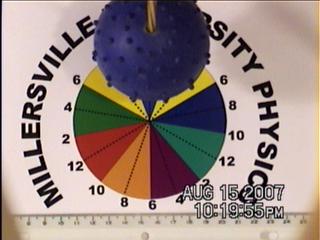Experiment of The Month
A Short, Driven, Foucault Pendulum
Our Science Design driven pendulum has been running for three years now. There is also a traditional monumental Foucault pendulum online, the Kirchhoff Institute of the University at Heidelberg
 The inspiration for this project was three-fold:
The inspiration for this project was three-fold:
1) The new science building at Millersville has a three story stairwell which cried out for a Foucault pendulum, but there was no money available for the standard monumental version (cost between $50,000 and $100,000).
2) Dr. Nolan found an article by Richard Crane showing that a short driven Foucault pendulum could be built. The reference is:
A Foucault Pendulum "Wall Clock"
by Richard H. Crane
American Journal of Physics 63, (1) 33-39 (1995).
3)Meron Wollie showed that we can parametrically drive a short pendulum with equipment readily at hand
To see a live image of the swinging pendulum click here. Log in as guest, with password guest. Choose the Java button to see the pendulum in motion.
At Millersville's latitude of about 40 degrees North, the pendulum should take about 36 hours to precess through an entire 360 degrees, meaning that it should precess about 10 degrees per hour.
The rate of rotation of the plane of oscillation is not constant, partly because of imperfections in the pivot point. More interestingly, the driving mechanism pulls up on the pivot each time the pendulum passes its low point. The brief upward velocity couples via the Coriolis force to induce a slight elliptical component to the motion. The elliptical path is clockwise because the direction of the Coriolis force. Because the period of the pendulum is slightly amplitude-dependent, the elliptical path precesses clockwise. Thus, the times marked on the scale below the pendulum must be regarded as an idealization. Our pendulum routinely turns a little bit fast.
The parametric drive mechanism used here is not the most common method of keeping up the motion of the pendulum. A monumental pendulum using a parametric drive was built in 1988 by Sir Brian Pippard, a physicist noted for his work on the properties of electrons in metals.
Click here for a 12 hour scrollable video of a 1 meter Foucault pendulum to see how it changes directions.
Click here for a bookmark with a quick explanation of the Foucault pendulum.
Click here for teaching suggestions for integrating the driven pendulum into an introductory physics course.
Click here for a discussion of the rotation of the plane of oscillation of the pendulum.
Click here for a discussion of how elliptical motion can make the pendulum plane rotate "too fast."
Click here for a large figure, showing 12 photos of one of our pendulums, in various positions throughout a single day.
Click Foucault pendulum at home for some "home-brew" ideas.
Click here for a discussion of the driving mechanism.
For a minute-by-minute record of another kind of real-time earthly motion, check out the MU Earth Science Seismograph page.